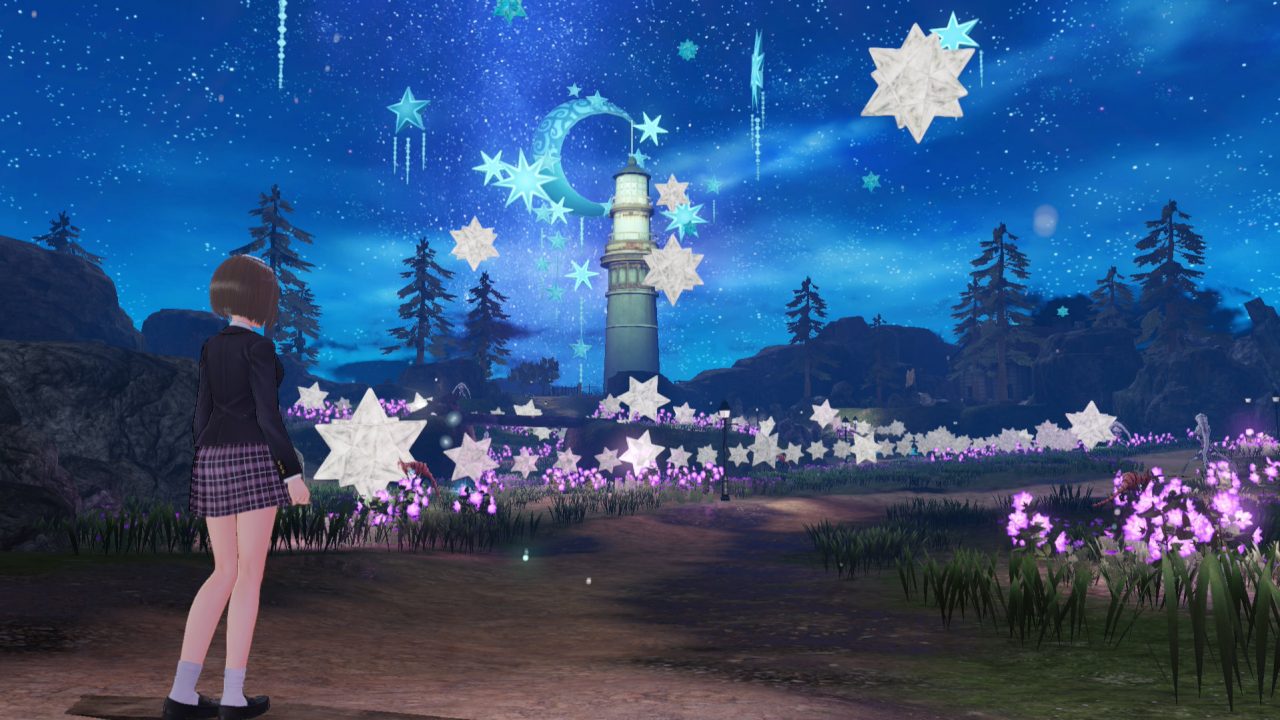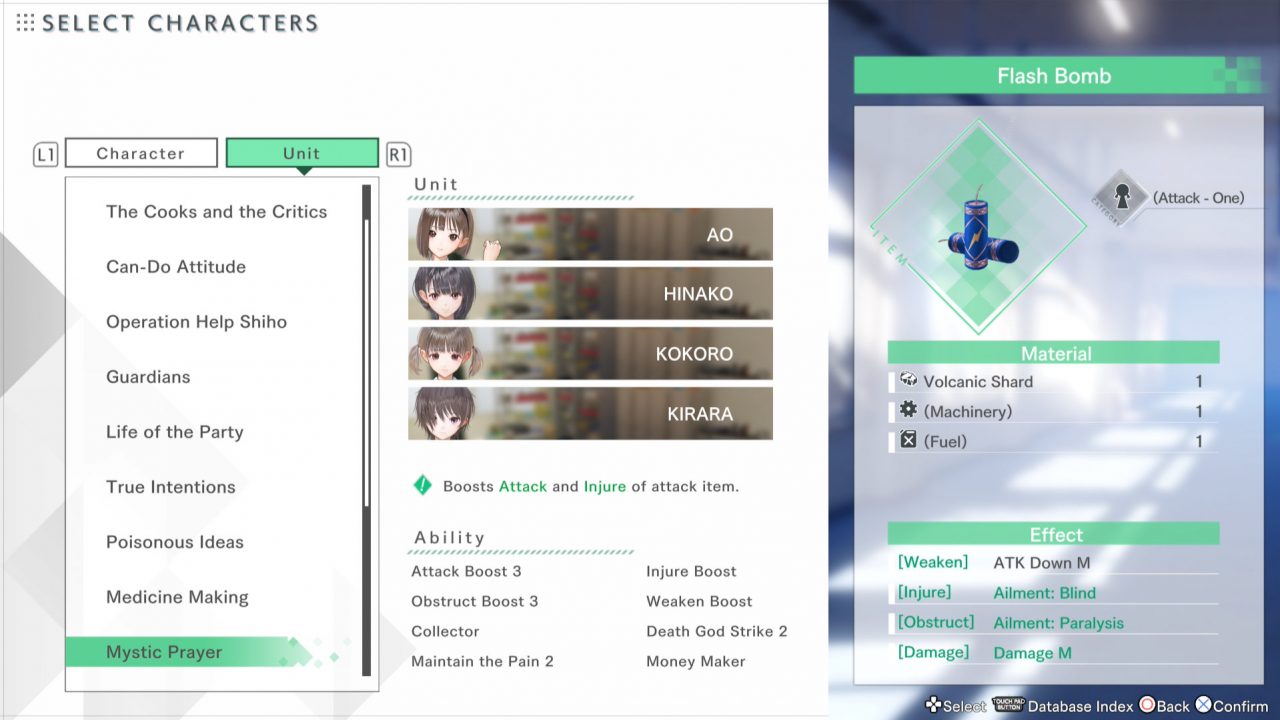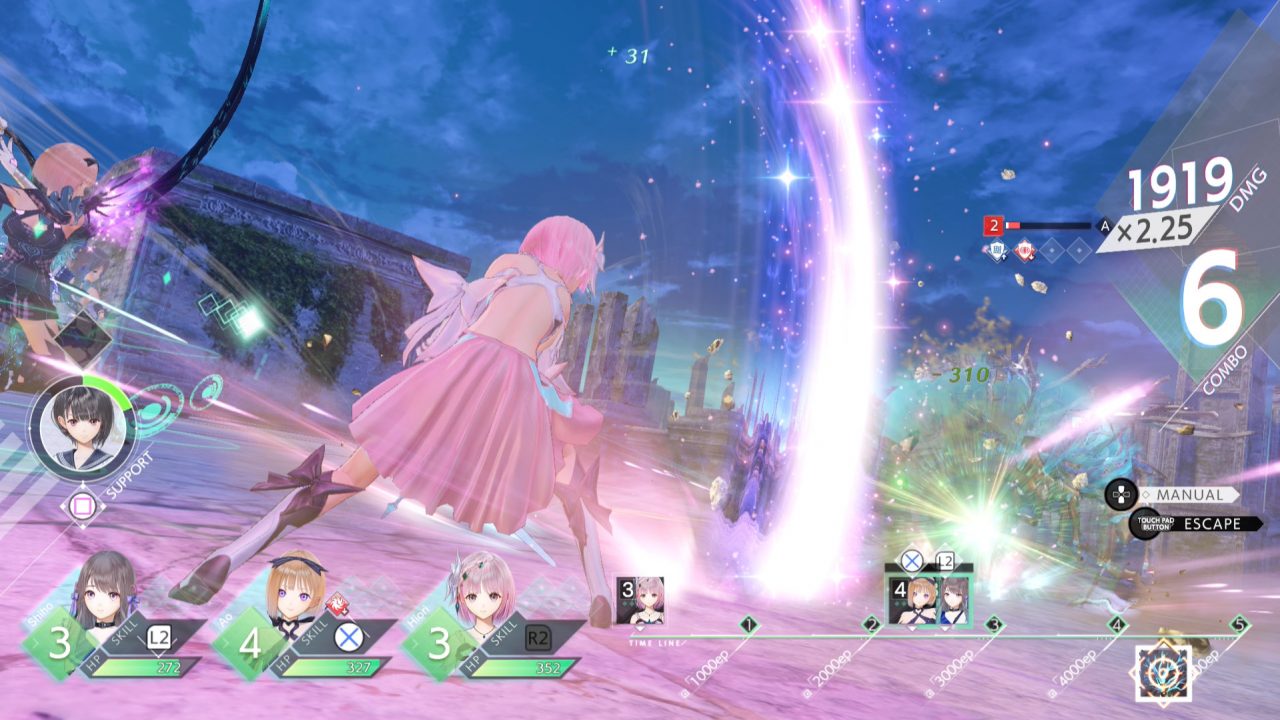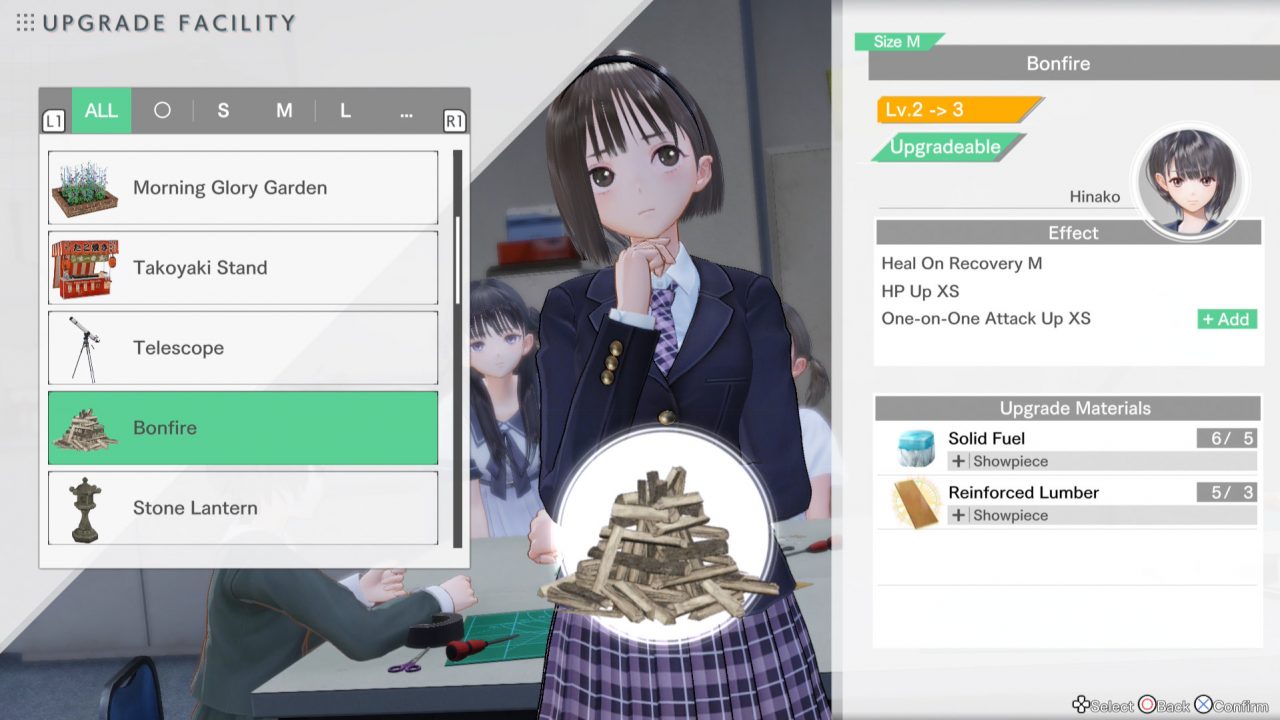Squid
New member
- PG Coin
- 34
The magical girl subgenre of media is a seemingly perfect fit for JRPGs. Vibrant transformations, flashy special attacks, cute mascots that may or may not be evil, coming-of-age tales, and a grand cast of characters battling against nefarious villains sound right at home with a genre that already has these elements. Sadly, there are painfully few magical girl games. When developer Gust announced Blue Reflection in 2017, I was elated as I grew up watching Sailor Moon alongside my little sister. I was excited to see one of my favorite developers tackle a subgenre I grew up with. While I greatly enjoyed the original, it was a bit low-budget and experimental. Now, four years later, Gust followed up with Blue Reflection: Second Light and the result is simply magical.
Along with its connection to the first game, Blue Reflection: Second Light is a sequel to the 2021 anime Blue Reflection Ray. It follows a group of girls led by Ao Hoshizaki — a quiet and lonely otaku who spends her days reading manga and watching anime. For all her life, she wished she could be someone special or interesting like the girls in her favorite series. One fateful day, she gets a mysterious text message and finds herself waking up in a new world surrounded by amnesiac girls. Soon after, Ao discovers she and the other girls are Reflectors — girls who fight demons and protect the emotions of others. They awake on a strange and lonely little island, robbed of their memories and their only shelter an oddly familiar school. Their goal quickly becomes clear: recover their memories and find out the truth about the world outside.
The story is a continuation of the events of Blue Reflection. It does recap some of the broader events of the first game, ensuring players don’t need to play the original. That said, there were numerous moments that hit much harder for me due to familiarity with the characters from the first game and their trials. The latter half of the game also touches upon the anime Blue Reflection Ray and even pulls in protagonists Hiori and Mio Hirahara alongside the villainous Uta Komagawa. Like the previous recap, this game offers a very broad overview of what happened in the anime while glossing over some dramatic moments. Watching the anime and playing the first game isn’t required, though I would highly recommend it to fully experience the dramatic moments that lead to this current game.

The Heartscapes are simply gorgeous.
Blue Reflection: Second Light is broken into four primary mechanics: exploration, crafting, development, and combat. Exploring, material gathering, and battles take place in the Heartscapes: locations made up of a Reflector’s memories and emotions. Throughout the Heartscapes, you find fragments of memories that give a bit of history on the Reflector in question. Additionally, broken pieces of past conversations may float near enemies, rest upon walls as you scale ladders, or even hover over large gaps that you’ll need to cross via precariously placed steel beams. Heartscapes are also where the majority of gathering takes place, as certain items are found in specific areas or as drops from particular enemies.
The materials gathered from Heartscapes can be used for both crafting and school development. The game’s crafting system is where it reveals itself as an Atelier-lite. Materials collected out in the world are components for healing, offensive, and support items. However, rather than a complex synthesis system that influences the quality or attributes of items, players instead choose who will help craft the recipe. Each character brings their own specialty to the table and gains more over the course of the game. Some may boost healing items, others may grant a chance to get new materials, and each has their own unique twist that can add potent bonus effects.
Development, on the other hand, is solely handled by the protagonist Ao. Throughout the game, there are various facilities to build and place around the school. Each facility has a unique effect like boosting stats, allowing items to be traded for coins, increasing EXP and item drops, or even offering trade-offs such as increased damage dealt in exchange for increased damage received. The school development system is somewhat similar to Nelke & The Legendary Alchemists: Ateliers of the New World and adds a fun twist on the system. Additionally, facilities have set bonuses that tie directly into gameplay. With a finite number of facility slots around the school, players need to pick and choose what they value most because many directly affect the battle system.

Blue Reflection: Second Light is secretly an Atelier game.
Blue Reflection: Second Light‘s combat system is a unique mix of ATB and Real Time with Pause. Action flows in real time as your characters build up magical energy (known as ether) to spend on attacks. However, when selecting your skills, the action pauses. In combat, characters utilize a Gear system akin to shifting gears in a vehicle. In higher Gears, ether recovery speed is increased alongside a higher ether cap. New and enhanced moves become available in higher Gears, and when hitting 3rd Gear, the characters transform into their Reflector form with new abilities and boosted stats. Each attack has its own ether cost and effects, yet in higher gears, the cost may go up with attacks improving or gaining additional effects.
The combat system is built upon acceleration and escalation. Everything is about speed, shifting gears, and getting access to more tools. Compared to the previous game’s battle system, the combat is much faster and more involved. While you can set the battle system to Auto let AI guide your Reflector team, manually controlling every action gives a more tactical feel, especially in boss fights. I found it incredibly rewarding to stack buffs on an ally just before she knocked the enemy down and made them susceptible to status ailments. While this was happening, I prepared another character to capitalize on the enemy’s downtime and stack as many debuffs and ailments as possible. Of course, just like in Atelier, stopping a boss dead in their tracks with an item and then wailing away with a barrage of magical attacks is both exciting and rewarding, more so when you crafted the item yourself with effects that add insult to injury.
On top of the Gear mechanic and the Atelier-esque itemization is the Combo system. In Blue Reflection: Second Light, every offensive action adds .25 to a combo multiplier. While your first hit boosts your multiplier to 1.00, it can climb to a maximum of 10.00 as battle progresses. So, while attacks may seem somewhat weak at first, doing 50 or so damage, the damage starts to skyrocket after a few hits. While the multiplier may not increase a lot in standard encounters, boss fights are where it really starts to climb. The Combo system ensures encounters are not overly long, and some characters manipulate the system in unique ways. The unit design is wonderful, as each character has their strengths, weaknesses, and specialties.

Battles are incredibly flashy, with colors bursting from every attack.
Finally, there is also the One-on-One Infight mechanic that either side can trigger. When knocking down a boss, shattering their shields will allow you to face off in a solo battle that takes place in real time. During these battles, the player can dodge, counter, attack, and buff themselves while racking up their combo and building up to a flashy special finisher. Once the One-on-One fight is over, the combos accrued are added to the general Combo system to further escalate the damage going out. The enemy can also use this mechanic to force a party member into a duel. Successfully countering and dodging their moves while dishing out some heavy blows is incredibly rewarding and quite fun. The battle system in Blue Reflection: Second Light is superb, exciting, and it makes every fight thoroughly enjoyable.
When not thrashing foes, crafting items, or gathering materials, players spend most of their time at the school with their fellow Reflectors. Character development is directly tied to completed requests for allies as well as the time spent with them. A character may want an item created, a foe slain, a material collected, or they may simply just want to talk. Blue Reflection: Second Light also introduces a Date system where the player may go on walks and converse with another character. Over time, they may get closer and hold hands as they walk along. After fulfilling requests or going on dates, allies will gain Talent Points and Fragments. The former are used to learn new abilities while the latter act as equipment to boost stats or add effects to skills. Talents also have multiple trees that unlock as players progress through the story.
Visually, Blue Reflection: Second Light is simply gorgeous. The Heartscapes are full of fantastical elements that show the artists put their hearts into their creations. When exploring the Heartscapes, I’d often stop and look around at the stunning locales and reflect on how they were an expression of the Reflector. The presentation in the Reflector’s memories is visually striking. Characters are simply silhouettes against an artistically textured and filtered backdrop that looks painted. The Reflectors themselves are also well-designed with a soft and unique style that Gust initially debuted in the previous game (alongside Atelier Ryza). In battle, flashy effects fly all over the screen while vibrant bursts of particles dance with every move. The animations are mostly smooth and exciting to watch, though there is the occasional stiff slide or awkward position.

Creating and upgrading facilities grants notable buffs.
Aurally, the game is a treat. Hayato Asano, the sole composer for Blue Reflection and notable contributor to the Atelier series, returns with another solo OST. Much like the previous soundtrack, it is magical in every way. Asano’s mastery shines through every track as he creates soothing and blissful piano-heavy songs that are both calming and enticing. Each of the Heartscapes has a wondrous theme that makes the fantastical elements stand out even more. While the previous game’s OST was slightly more exciting due to unique boss themes with special versions for each phase, Blue Reflection: Second Light‘s OST feels more balanced overall. The battle themes are expectedly incredible and show that Asano is still a master of the artcore subgenre. However, the more ambient themes aren’t as overshadowed this time around. Every single musical piece is elevated and given enough room to breathe, and the experience overall is extremely pleasant. It feels as if every note of the series’ motif is mapped directly to the heartstrings.
My time with Blue Reflection: Second Light was incredibly enjoyable over the 50 hours I put into it. As a big fan of the first game, I always felt it would be left as a one-off magical girl JRPG that would be forgotten. Naturally, I was both caught off guard and excited to learn that an anime and two more games were in the works. While I’ve consumed both the first game and the anime, the game makes references to events of the third game, slated for mobile and PC sometime in the future. This can lead to some light confusion in the story regarding how a few characters interacted prior to arriving on the island. Thankfully, this is fairly minor. Finally, the game does have a few stiff animations and the occasional bug or glitch, but I found these to be infrequent.
Blue Reflection: Second Light is a beautiful game in every way. It looks fantastic, plays great, and sounds incredible. It’s challenging, rewarding, and a unique experience through and through. It has a hopeful, positive message and the story is a fun and winding ride. The presentation is top-notch, and the game itself demonstrates what Gust has learned in the past four years from their Atelier games. For those looking for a magical girl JRPG to play, consider checking out the entire series. For fans of the original game and anime, I highly recommend Blue Reflection: Second Light. It is one of Gust’s best games to date and easily the best game in the magical girl media subgenre.
Continue reading...
Along with its connection to the first game, Blue Reflection: Second Light is a sequel to the 2021 anime Blue Reflection Ray. It follows a group of girls led by Ao Hoshizaki — a quiet and lonely otaku who spends her days reading manga and watching anime. For all her life, she wished she could be someone special or interesting like the girls in her favorite series. One fateful day, she gets a mysterious text message and finds herself waking up in a new world surrounded by amnesiac girls. Soon after, Ao discovers she and the other girls are Reflectors — girls who fight demons and protect the emotions of others. They awake on a strange and lonely little island, robbed of their memories and their only shelter an oddly familiar school. Their goal quickly becomes clear: recover their memories and find out the truth about the world outside.
The story is a continuation of the events of Blue Reflection. It does recap some of the broader events of the first game, ensuring players don’t need to play the original. That said, there were numerous moments that hit much harder for me due to familiarity with the characters from the first game and their trials. The latter half of the game also touches upon the anime Blue Reflection Ray and even pulls in protagonists Hiori and Mio Hirahara alongside the villainous Uta Komagawa. Like the previous recap, this game offers a very broad overview of what happened in the anime while glossing over some dramatic moments. Watching the anime and playing the first game isn’t required, though I would highly recommend it to fully experience the dramatic moments that lead to this current game.

The Heartscapes are simply gorgeous.
Blue Reflection: Second Light is broken into four primary mechanics: exploration, crafting, development, and combat. Exploring, material gathering, and battles take place in the Heartscapes: locations made up of a Reflector’s memories and emotions. Throughout the Heartscapes, you find fragments of memories that give a bit of history on the Reflector in question. Additionally, broken pieces of past conversations may float near enemies, rest upon walls as you scale ladders, or even hover over large gaps that you’ll need to cross via precariously placed steel beams. Heartscapes are also where the majority of gathering takes place, as certain items are found in specific areas or as drops from particular enemies.
The materials gathered from Heartscapes can be used for both crafting and school development. The game’s crafting system is where it reveals itself as an Atelier-lite. Materials collected out in the world are components for healing, offensive, and support items. However, rather than a complex synthesis system that influences the quality or attributes of items, players instead choose who will help craft the recipe. Each character brings their own specialty to the table and gains more over the course of the game. Some may boost healing items, others may grant a chance to get new materials, and each has their own unique twist that can add potent bonus effects.
Development, on the other hand, is solely handled by the protagonist Ao. Throughout the game, there are various facilities to build and place around the school. Each facility has a unique effect like boosting stats, allowing items to be traded for coins, increasing EXP and item drops, or even offering trade-offs such as increased damage dealt in exchange for increased damage received. The school development system is somewhat similar to Nelke & The Legendary Alchemists: Ateliers of the New World and adds a fun twist on the system. Additionally, facilities have set bonuses that tie directly into gameplay. With a finite number of facility slots around the school, players need to pick and choose what they value most because many directly affect the battle system.

Blue Reflection: Second Light is secretly an Atelier game.
Blue Reflection: Second Light‘s combat system is a unique mix of ATB and Real Time with Pause. Action flows in real time as your characters build up magical energy (known as ether) to spend on attacks. However, when selecting your skills, the action pauses. In combat, characters utilize a Gear system akin to shifting gears in a vehicle. In higher Gears, ether recovery speed is increased alongside a higher ether cap. New and enhanced moves become available in higher Gears, and when hitting 3rd Gear, the characters transform into their Reflector form with new abilities and boosted stats. Each attack has its own ether cost and effects, yet in higher gears, the cost may go up with attacks improving or gaining additional effects.
The combat system is built upon acceleration and escalation. Everything is about speed, shifting gears, and getting access to more tools. Compared to the previous game’s battle system, the combat is much faster and more involved. While you can set the battle system to Auto let AI guide your Reflector team, manually controlling every action gives a more tactical feel, especially in boss fights. I found it incredibly rewarding to stack buffs on an ally just before she knocked the enemy down and made them susceptible to status ailments. While this was happening, I prepared another character to capitalize on the enemy’s downtime and stack as many debuffs and ailments as possible. Of course, just like in Atelier, stopping a boss dead in their tracks with an item and then wailing away with a barrage of magical attacks is both exciting and rewarding, more so when you crafted the item yourself with effects that add insult to injury.
On top of the Gear mechanic and the Atelier-esque itemization is the Combo system. In Blue Reflection: Second Light, every offensive action adds .25 to a combo multiplier. While your first hit boosts your multiplier to 1.00, it can climb to a maximum of 10.00 as battle progresses. So, while attacks may seem somewhat weak at first, doing 50 or so damage, the damage starts to skyrocket after a few hits. While the multiplier may not increase a lot in standard encounters, boss fights are where it really starts to climb. The Combo system ensures encounters are not overly long, and some characters manipulate the system in unique ways. The unit design is wonderful, as each character has their strengths, weaknesses, and specialties.

Battles are incredibly flashy, with colors bursting from every attack.
Finally, there is also the One-on-One Infight mechanic that either side can trigger. When knocking down a boss, shattering their shields will allow you to face off in a solo battle that takes place in real time. During these battles, the player can dodge, counter, attack, and buff themselves while racking up their combo and building up to a flashy special finisher. Once the One-on-One fight is over, the combos accrued are added to the general Combo system to further escalate the damage going out. The enemy can also use this mechanic to force a party member into a duel. Successfully countering and dodging their moves while dishing out some heavy blows is incredibly rewarding and quite fun. The battle system in Blue Reflection: Second Light is superb, exciting, and it makes every fight thoroughly enjoyable.
When not thrashing foes, crafting items, or gathering materials, players spend most of their time at the school with their fellow Reflectors. Character development is directly tied to completed requests for allies as well as the time spent with them. A character may want an item created, a foe slain, a material collected, or they may simply just want to talk. Blue Reflection: Second Light also introduces a Date system where the player may go on walks and converse with another character. Over time, they may get closer and hold hands as they walk along. After fulfilling requests or going on dates, allies will gain Talent Points and Fragments. The former are used to learn new abilities while the latter act as equipment to boost stats or add effects to skills. Talents also have multiple trees that unlock as players progress through the story.
Visually, Blue Reflection: Second Light is simply gorgeous. The Heartscapes are full of fantastical elements that show the artists put their hearts into their creations. When exploring the Heartscapes, I’d often stop and look around at the stunning locales and reflect on how they were an expression of the Reflector. The presentation in the Reflector’s memories is visually striking. Characters are simply silhouettes against an artistically textured and filtered backdrop that looks painted. The Reflectors themselves are also well-designed with a soft and unique style that Gust initially debuted in the previous game (alongside Atelier Ryza). In battle, flashy effects fly all over the screen while vibrant bursts of particles dance with every move. The animations are mostly smooth and exciting to watch, though there is the occasional stiff slide or awkward position.

Creating and upgrading facilities grants notable buffs.
Aurally, the game is a treat. Hayato Asano, the sole composer for Blue Reflection and notable contributor to the Atelier series, returns with another solo OST. Much like the previous soundtrack, it is magical in every way. Asano’s mastery shines through every track as he creates soothing and blissful piano-heavy songs that are both calming and enticing. Each of the Heartscapes has a wondrous theme that makes the fantastical elements stand out even more. While the previous game’s OST was slightly more exciting due to unique boss themes with special versions for each phase, Blue Reflection: Second Light‘s OST feels more balanced overall. The battle themes are expectedly incredible and show that Asano is still a master of the artcore subgenre. However, the more ambient themes aren’t as overshadowed this time around. Every single musical piece is elevated and given enough room to breathe, and the experience overall is extremely pleasant. It feels as if every note of the series’ motif is mapped directly to the heartstrings.
My time with Blue Reflection: Second Light was incredibly enjoyable over the 50 hours I put into it. As a big fan of the first game, I always felt it would be left as a one-off magical girl JRPG that would be forgotten. Naturally, I was both caught off guard and excited to learn that an anime and two more games were in the works. While I’ve consumed both the first game and the anime, the game makes references to events of the third game, slated for mobile and PC sometime in the future. This can lead to some light confusion in the story regarding how a few characters interacted prior to arriving on the island. Thankfully, this is fairly minor. Finally, the game does have a few stiff animations and the occasional bug or glitch, but I found these to be infrequent.
Blue Reflection: Second Light is a beautiful game in every way. It looks fantastic, plays great, and sounds incredible. It’s challenging, rewarding, and a unique experience through and through. It has a hopeful, positive message and the story is a fun and winding ride. The presentation is top-notch, and the game itself demonstrates what Gust has learned in the past four years from their Atelier games. For those looking for a magical girl JRPG to play, consider checking out the entire series. For fans of the original game and anime, I highly recommend Blue Reflection: Second Light. It is one of Gust’s best games to date and easily the best game in the magical girl media subgenre.
Continue reading...
